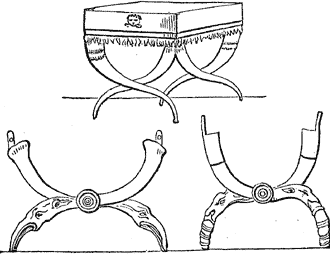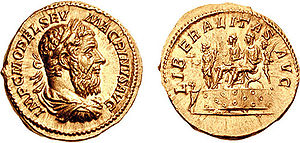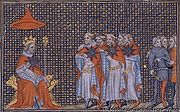
Curule chair
Encyclopedia


Roman Republic
The Roman Republic was the period of the ancient Roman civilization where the government operated as a republic. It began with the overthrow of the Roman monarchy, traditionally dated around 508 BC, and its replacement by a government headed by two consuls, elected annually by the citizens and...
, and later the Empire, the curule seat (sella curulis, supposedly from currus, "chariot") was the chair upon which senior magistrates or promagistrates owning imperium
Imperium
Imperium is a Latin word which, in a broad sense, translates roughly as 'power to command'. In ancient Rome, different kinds of power or authority were distinguished by different terms. Imperium, referred to the sovereignty of the state over the individual...
were entitled to sit, including dictator
Roman dictator
In the Roman Republic, the dictator , was an extraordinary magistrate with the absolute authority to perform tasks beyond the authority of the ordinary magistrate . The office of dictator was a legal innovation originally named Magister Populi , i.e...
s, masters of the horse
Master of the Horse
The Master of the Horse was a position of varying importance in several European nations.-Magister Equitum :...
, consul
Consul
Consul was the highest elected office of the Roman Republic and an appointive office under the Empire. The title was also used in other city states and also revived in modern states, notably in the First French Republic...
s, praetor
Praetor
Praetor was a title granted by the government of Ancient Rome to men acting in one of two official capacities: the commander of an army, usually in the field, or the named commander before mustering the army; and an elected magistratus assigned varied duties...
s, censors, and the curule aediles. Additionally, the Flamen
Flamen
In ancient Roman religion, a flamen was a priest assigned to one of fifteen deities with official cults during the Roman Republic. The most important three were the flamines maiores , who served the three chief Roman gods of the Archaic Triad. The remaining twelve were the flamines minores...
of Jupiter (Flamen Dialis) was also allowed to sit on a sella curulis, though this position lacked imperium.
According to Livy
Livy
Titus Livius — known as Livy in English — was a Roman historian who wrote a monumental history of Rome and the Roman people. Ab Urbe Condita Libri, "Chapters from the Foundation of the City," covering the period from the earliest legends of Rome well before the traditional foundation in 753 BC...
the curule seat, like the Roman toga
Toga
The toga, a distinctive garment of Ancient Rome, was a cloth of perhaps 20 ft in length which was wrapped around the body and was generally worn over a tunic. The toga was made of wool, and the tunic under it often was made of linen. After the 2nd century BC, the toga was a garment worn...
, originated in Etruria
Etruria
Etruria—usually referred to in Greek and Latin source texts as Tyrrhenia—was a region of Central Italy, an area that covered part of what now are Tuscany, Latium, Emilia-Romagna, and Umbria. A particularly noteworthy work dealing with Etruscan locations is D. H...
, and it has been used on surviving Etruscan monuments to identify magistrates, but much earlier stools supported on a cross-frame are known from the New Kingdom of Egypt. According to Cassius Dio, early in 44 BC a senate decree granted Julius Caesar
Julius Caesar
Gaius Julius Caesar was a Roman general and statesman and a distinguished writer of Latin prose. He played a critical role in the gradual transformation of the Roman Republic into the Roman Empire....
the sella curulis everywhere except in the theatre, where his gilded
Gilding
The term gilding covers a number of decorative techniques for applying fine gold leaf or powder to solid surfaces such as wood, stone, or metal to give a thin coating of gold. A gilded object is described as "gilt"...
chair and jeweled crown were carried in, putting him on a par with the gods. As a form of throne
Throne
A throne is the official chair or seat upon which a monarch is seated on state or ceremonial occasions. "Throne" in an abstract sense can also refer to the monarchy or the Crown itself, an instance of metonymy, and is also used in many expressions such as "the power behind the...
, the sella might be given as an honor to foreign kings recognized formally as friend (amicus) by the Roman people or senate
Roman Senate
The Senate of the Roman Republic was a political institution in the ancient Roman Republic, however, it was not an elected body, but one whose members were appointed by the consuls, and later by the censors. After a magistrate served his term in office, it usually was followed with automatic...
.
The curule chair is used on Roman medals as well as funerary monuments to express a curule magistracy; when traversed by a hasta
Hasta (spear)
Hasta is a Latin word meaning spear. Hastae were carried by early Roman Legionaries, in particular they were carried by and gave their name to those Roman soldiers known as Hastati...
(spear), it is the symbol of Juno
Juno (mythology)
Juno is an ancient Roman goddess, the protector and special counselor of the state. She is a daughter of Saturn and sister of the chief god Jupiter and the mother of Mars and Vulcan. Juno also looked after the women of Rome. Her Greek equivalent is Hera...
.
The curule chair was traditionally made of or veneered with ivory
Ivory
Ivory is a term for dentine, which constitutes the bulk of the teeth and tusks of animals, when used as a material for art or manufacturing. Ivory has been important since ancient times for making a range of items, from ivory carvings to false teeth, fans, dominoes, joint tubes, piano keys and...
, with curved legs forming a wide X; it had no back, and low arms. Although often of luxurious construction, the Roman curule was meant to be uncomfortable to sit on for long periods of time, the double symbolism being that the official was expected to carry out his public function in an efficient and timely manner, and that his office, being an office of the republic
Roman Republic
The Roman Republic was the period of the ancient Roman civilization where the government operated as a republic. It began with the overthrow of the Roman monarchy, traditionally dated around 508 BC, and its replacement by a government headed by two consuls, elected annually by the citizens and...
, was temporary, not perennial. The chair could be folded, and thus an easily transportable seat, originally for magisterial and promagisterial commanders in the field, developed a hieratic significance, expressed in fictive curule seats on funerary monuments, a symbol of power which was never entirely lost in post-Roman European tradition. 6th-century consular ivory diptych
Diptych
A diptych di "two" + ptychē "fold") is any object with two flat plates attached at a hinge. Devices of this form were quite popular in the ancient world, wax tablets being coated with wax on inner faces, for recording notes and for measuring time and direction.In Late Antiquity, ivory diptychs with...
s of Orestes and of Constantinus each depict the consul seated on an elaborate curule seat with crossed animal legs.
Along the Silk Road
Silk Road
The Silk Road or Silk Route refers to a historical network of interlinking trade routes across the Afro-Eurasian landmass that connected East, South, and Western Asia with the Mediterranean and European world, as well as parts of North and East Africa...
the folding seat of the Eastern Roman Empire made its way to China, where in various forms including the hu chuang— the "barbarian bed"— it "transformed the dress, architecture and lifestyle of the Chinese" In Han China the folding chair made its first literary mark in the 2nd century AD, used out-of-doors in a military rather than domestic setting, and from the way it was addressed in a poem by Yu Jianwu, written about 552
By the name name handed down you are from a foreign region
coming into [China] and being used in the capital
With legs leaning your frame adjusts by itself
With limbs slanting your body levels by itself...
it is clear the cross-framed folding seat was intended.

Capetian
Capetian is an adjective, used to describe either:* The House of Capet, also called the Direct Capetians – the ruling family of France between 987 and 1328* The Capetian dynasty, a term applied to all direct descendants of Hugh Capet...
successors retained the iconic seat: the "Throne of Dagobert
Dagobert I
Dagobert I was the king of Austrasia , king of all the Franks , and king of Neustria and Burgundy . He was the last Merovingian dynast to wield any real royal power...
", of cast bronze retaining traces of its former gilding, is conserved in the Bibliothèque nationale de France
Bibliothèque nationale de France
The is the National Library of France, located in Paris. It is intended to be the repository of all that is published in France. The current president of the library is Bruno Racine.-History:...
. The "throne of Dagobert" is first mentioned in the 12th century, already as a treasured relic, by Abbot Suger
Abbot Suger
Suger was one of the last Frankish abbot-statesmen, an historian, and the influential first patron of Gothic architecture....
, who claims in his Administratione, "We also restored the noble throne of the glorious King Dagobert, on which, as tradition relates, the Frankish kings sat to receive the homage of their nobles after they had assumed power. We did so in recognition of its exalted function and because of the value of the work itself." Abbot Suger added bronze upper members with foliated scrolls and a back-piece. The "Throne of Dagobert" was coarsely repaired and used for the coronation of Napoleon.

X-chair
An X-chair is a chair with X-shaped frame. It was known in Ancient Egypt, Rome, and Greece.- History :...
of both Italy and Spain was made of numerous shaped cross-framed elements, joined to wooden members that rested on the floor and further made rigid with a wooden back. 19th-century dealers and collectors termed these "Dante Chairs" or "Savonarola Chairs", with disregard to the centuries intervening between the two figures. Examples of curule seats were redrawn from a 15th-century manuscript of the Roman de Renaude de Montauban and published in Henry Shaw's Specimens of Ancient Furniture (1836).
The 15th or early 16th-century curule seat that survives at York Minster
York Minster
York Minster is a Gothic cathedral in York, England and is one of the largest of its kind in Northern Europe alongside Cologne Cathedral. The minster is the seat of the Archbishop of York, the second-highest office of the Church of England, and is the cathedral for the Diocese of York; it is run by...
, originally entirely covered with textiles, has rear members extended upwards to form a back, between which a rich textile was stretched. The cross-framed armchair, no longer actually a folding chair, continued to have regal connotations. James I of England
James I of England
James VI and I was King of Scots as James VI from 24 July 1567 and King of England and Ireland as James I from the union of the English and Scottish crowns on 24 March 1603...
was portrayed with such a chair, its framing entirely covered with a richly patterned silk damask textile, with decorative nailing, in Paul van Somer
Paul van Somer I
Paul van Somer , also known as Paulus van Somer, was a Flemish artist who arrived in England from Antwerp during the reign of King James I of England and became one of the leading painters of the royal court...
's portrait (illustration, left). Similar early 17th-century cross-framed seats survive at Knole, perquisites from a royal event.

Prince Hamlet
Prince Hamlet is a fictional character, the protagonist in Shakespeare's tragedy Hamlet. He is the Prince of Denmark, nephew to the usurping Claudius and son of the previous King of Denmark, Old Hamlet. Throughout the play he struggles with whether, and how, to avenge the murder of his father, and...
(illustration, right) poses him in a regal cross-framed chair, considered suitably medieval in 1870.
The form found its way into stylish but non-royal decoration in the archaeological second phase of neoclassicism
Neoclassicism
Neoclassicism is the name given to Western movements in the decorative and visual arts, literature, theatre, music, and architecture that draw inspiration from the "classical" art and culture of Ancient Greece or Ancient Rome...
in the early 19th century. An unusually early example of this revived form is provided by the large sets of richly carved and gilded pliants (folding stools) forming part of long sets with matching tabourets delivered in 1786 to the royal châteaux of Compiègne
Château de Compiègne
The Castle of Compiègne is a French château, a royal residence built for Louis XV and restored by Napoleon. Compiègne was one of three seats of royal government, the others being Versailles and Fontainebleau...
and Fontainebleau
Château de Fontainebleau
The Palace of Fontainebleau, located 55 kilometres from the centre of Paris, is one of the largest French royal châteaux. The palace as it is today is the work of many French monarchs, building on an early 16th century structure of Francis I. The building is arranged around a series of courtyards...
. With their Imperial Roman connotations, the backless curule seats found their way into furnishings for Napoleon, who moved some of the former royal pliants into his state bedchamber at Fontainebleau. Further examples were ordered, in the newest Empire taste: Jacob-Desmalter's seats with members in the form of carved and gilded sheathed sabres were delivered to Saint-Cloud
Château de Saint-Cloud
The Château de Saint-Cloud was a Palace in France, built on a magnificent site overlooking the Seine at Saint-Cloud in Hauts-de-Seine, about 10 kilometres west of Paris. Today it is a large park on the outskirts of the capital and is owned by the state, but the area as a whole has had a large...
about 1805. Cross-framed drawing-room chairs are illustrated in Thomas Sheraton
Thomas Sheraton
Thomas Sheraton was a furniture designer, one of the "big three" English furniture makers of the 18th century, along with Thomas Chippendale and George Hepplewhite.-Biography:...
's last production, The Cabinet-Maker, Upholsterer and General Artist's Encyclopaedia (1806), and in Thomas Hope's Household Furniture (1807).
With the decline of archaeological neoclassicism, the curule chair disappeared; it is not found among Biedermeier
Biedermeier
In Central Europe, the Biedermeier era refers to the middle-class sensibilities of the historical period between 1815, the year of the Congress of Vienna at the end of the Napoleonic Wars, and 1848, the year of the European revolutions...
and other Late Classical furnishing schemes.

